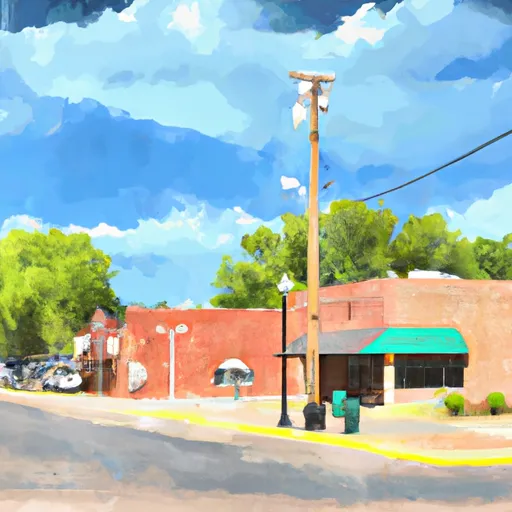-
 Snoflo Premium
Snoflo Premium
Get unlimited access to all our content
With no Ad interruptions! - Start Your Free Trial Login with existing account
Meno
Eden Index
Climate
8.3
•
Recreation
•
Community
•
Safeguard
3.3/10

Meno, Oklahoma is a small town located in Major County. The climate in Meno is classified as continental, characterized by hot summers and cold winters. Summers are typically hot and humid, with temperatures often reaching the mid to high 90s Fahrenheit, while winters are cold with temperatures dropping below freezing, occasionally accompanied by snowfall.
Hydrologically, Meno is situated in an area with limited surface water resources. However, the town does have access to groundwater sources, which are essential for agriculture and residential use. The water in Meno is typically hard, containing minerals such as calcium and magnesium.
Despite its small size, Meno offers various outdoor recreation opportunities. The surrounding countryside provides ample space for activities such as hiking, bird-watching, and wildlife photography. Additionally, the region boasts several lakes and reservoirs within a short driving distance, where residents and visitors can enjoy fishing, boating, and swimming during the summer months. Outdoor enthusiasts can also explore nearby state parks and conservation areas, offering trails for hiking, biking, and camping.
In summary, Meno, Oklahoma experiences a continental climate with hot summers and cold winters. The town relies on groundwater sources due to limited surface water availability. Outdoor recreation opportunities in Meno and its surroundings include hiking, fishing, boating, and camping, offering residents and visitors a chance to enjoy the natural beauty of the area.
What is the Eden Index?
The Snoflo Eden Index serves as a comprehensive rating system for regions, evaluating their desirability through a holistic assessment of climate health, outdoor recreation opportunities, and natural disaster risk, acknowledging the profound impact of these factors on livability and well-being.
Climate Health Indicator (CHI): 8.3
Meno receives approximately
791mm of rain per year,
with humidity levels near 81%
and air temperatures averaging around
15°C.
Meno has a plant hardyness factor of
7, meaning
plants and agriculture in this region tend to thrive during the non-winter months.
By considering the ideal temperature range, reliable water supplies, clean air, and stable seasonal rain or snowpacks, the Climate Health Indicator (CHI) underscores the significance of a healthy climate as the foundation for quality living.
A healthy climate is paramount for ensuring a high quality of life and livability in a region, fostering both physical well-being and environmental harmony. This can be characterized by ideal temperatures, reliable access to water supplies, clean air, and consistent seasonal rain or snowpacks.
Weather Forecast
Streamflow Conditions
Lower Cimarron
Area Rivers
Lower Cimarron
Snowpack Depths
Lower Cimarron
Reservoir Storage Capacity
Lower Cimarron
Groundwater Levels
Recreational Opportunity Index (ROI):
The Recreational Opportunity Index (ROI) recognizes the value of outdoor recreational options, such as parks, hiking trails, camping sites, and fishing spots, while acknowledging that climate plays a pivotal role in ensuring the comfort and consistency of these experiences.
Access to outdoor recreational opportunities, encompassing activities such as parks, hiking, camping, and fishing, is crucial for overall well-being, and the climate plays a pivotal role in enabling and enhancing these experiences, ensuring that individuals can engage in nature-based activities comfortably and consistently.
Camping Areas
| Campground | Campsites | Reservations | Toilets | Showers | Elevation |
|---|---|---|---|---|---|
| Cherokee City RV Park | 16 | 1,180 ft | |||
| Great Salt Plains State Park | None | 1,144 ft | |||
| Lake Chickasha | 50 | 1,207 ft | |||
| Anthony City Lake | 66 | 1,343 ft | |||
| Randlett Park | None | 1,192 ft |
Nearby Fishing
Nearby Ski Areas
Catastrophe Safeguard Index (CSI):
The Catastrophe Safeguard Index (CSI) recognizes that natural disaster risk, encompassing floods, fires, hurricanes, and tornadoes, can drastically affect safety and the overall appeal of an area.
The level of natural disaster risk in a region significantly affects safety and the overall livability, with climate change amplifying these risks by potentially increasing the frequency and intensity of events like floods, fires, hurricanes, and tornadoes, thereby posing substantial challenges to community resilience and well-being.
Community Resilience Indicator (CRI):
The Community Resilience Indicator (CRI) recognizes that education, healthcare, and socioeconomics are crucial to the well-being of a region. The CRI acknowledges the profound impact of these elements on residents' overall quality of life. By evaluating educational resources, healthcare accessibility, and economic inclusivity, the index captures the essential aspects that contribute to a thriving community, fostering resident satisfaction, equity, and social cohesion.

